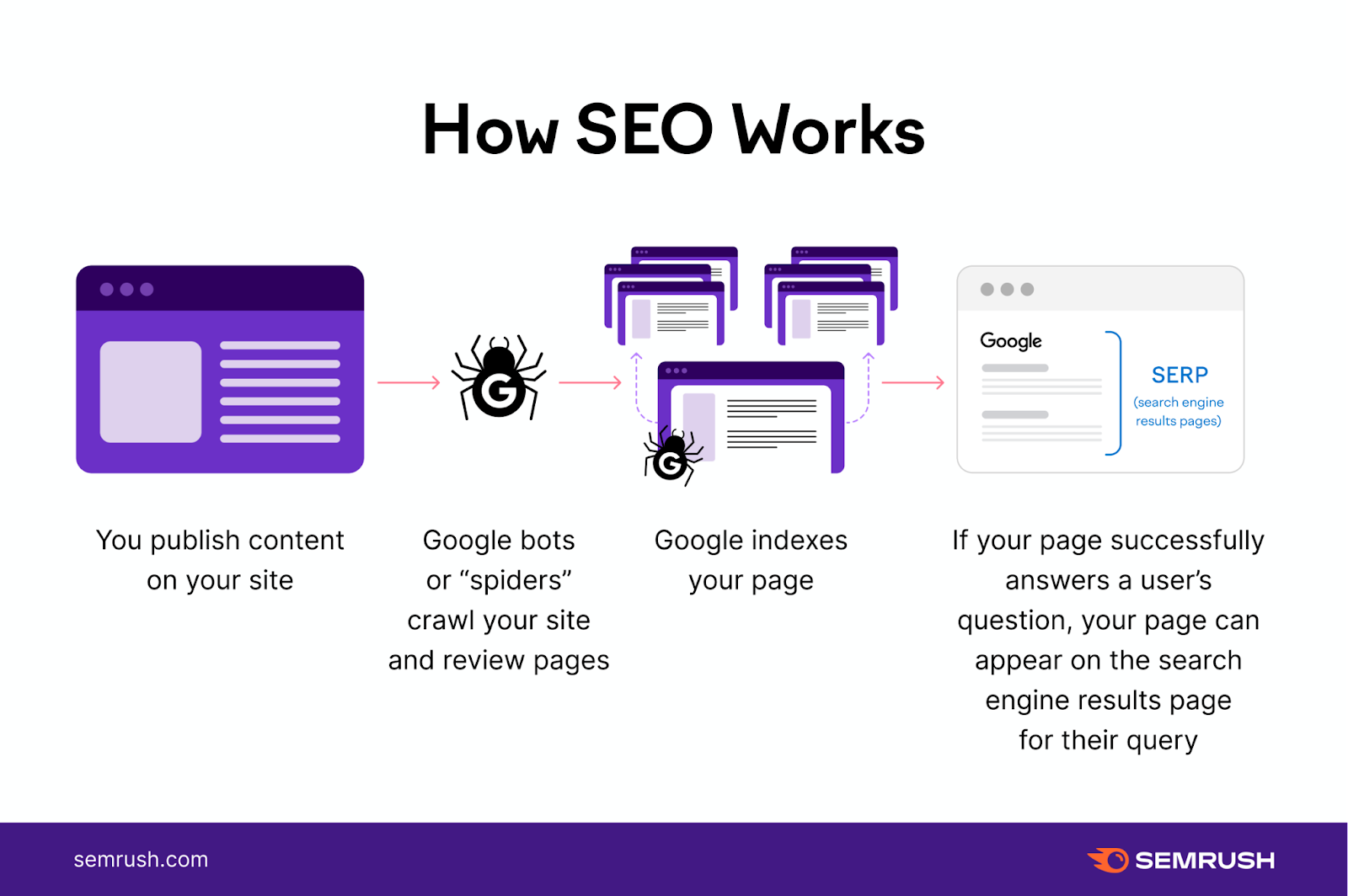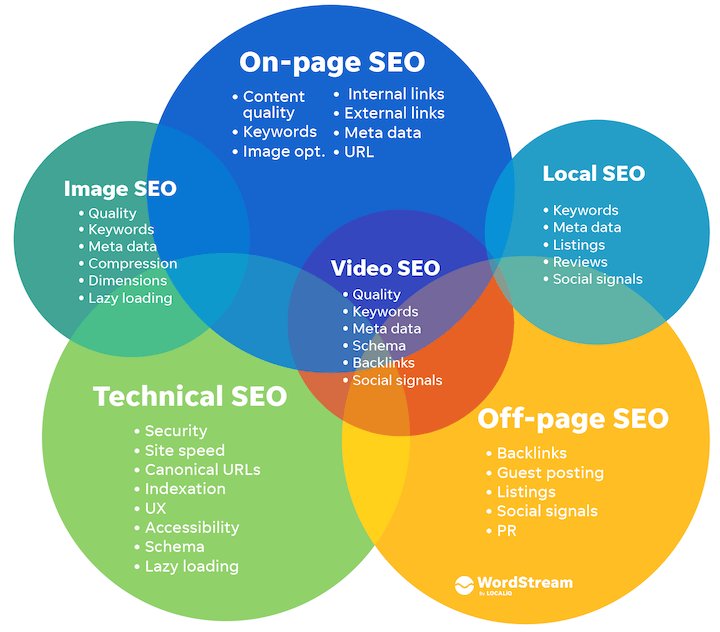What is search engine optimization (SEO)?
Search engine optimization (SEO) is the technique of optimizing a website or web page to improve its ranking in search engine results pages (SERPs). It entails making adjustments and upgrades to a website’s technical setup, content relevancy, and link popularity in order to make its pages more accessible, relevant, and popular for user web searches, and as a result, for search engines to rank them better.

In simple words, SEO involves making improvements to your website’s content and structure to make it easier for individuals using search engines to find everything you have to offer.
How does SEO work
The below infographic explains in a simple way how SEO works:

Image source: Semrush
Importance of SEO in marketing
SEO is an important aspect of digital marketing because it helps to improve the visibility and ranking of a website or web page in search engine results pages (SERPs). When a website or web page ranks highly in search results, it is more likely to be seen by users, which can drive more traffic to the site.
Here are some specific ways in which SEO can be important for marketing:
Attracting qualified traffic
By optimizing a website or web page for relevant keywords, businesses and organizations can attract visitors who are actively searching for the products or services they offer.
Increasing brand awareness
A high rank in search results can help to increase the visibility and awareness of a brand, especially if the website or web page appears at the top of search results for branded keywords.
Generating leads and sales
By attracting qualified traffic to a website or web page, businesses and organizations can generate leads and sales from interested users.
Providing a good user experience
A well-optimized website or web page can be easier for users to navigate and use, which can improve the overall user experience and encourage more people to visit and stay on the site.
Types of SEO
There are several types of SEO, including:
On-page SEO
This refers to the optimization of individual web pages and content on them in order to rank higher and earn more relevant traffic in search engines. On-page SEO includes:
- Title tags
- Meta descriptions
- Content quality
- Keywords
- Images
- URLs
- Headlines
Off-page SEO
This refers to the process of building links from other websites to a website or web page to improve its ranking in search results. Off-page SEO includes tactics like:
- Link building
- Social media marketing
- Guest blogging
- Customer reviews and testimonials
- Influencer marketing
Technical SEO
This refers to the optimization of the technical aspects of a website or web page. Technical SEO is important because it can impact the crawling ability and indexability of a website, which can affect its ranking in search results. Some of the aspects to be taken care of are:
- Website architecture
- Site Security
- Sitemaps
- Structure (CSS, HTML)
- Page speed
- Crawlability
- Schema
A few more subtypes of SEO are as below:
Local SEO
This refers to the amplification of a website for local search results. Local SEO is important for businesses and organizations that serve a local market, as it can help them to rank higher in search results for keywords related to their location.
Image SEO
This comprises a mix of on-page and technical strategies to get images on your website pages to rank in Google image search.
Video SEO
This type is a mix of on-page, technical, and off-page strategies to get your videos to rank in YouTube or Google video results.
The below infographic straightforwardly explains the types of SEOs:

SEO strategies
There are many different SEO strategies that businesses and organizations can use to improve their ranking in search engine results pages (SERPs). Here are a few common approaches:
Keyword research
Identifying and targeting relevant keywords that people are searching for can help to improve a website or web page’s ranking in search results.
On-page optimization
Making sure that the content and structure of a website or web page are optimized for search engines can help to improve its ranking in search results. This can include things like using header tags, optimizing images and videos, and using internal and external links.
Off-page optimization
Building links from other websites to a website or web page can help to improve its authority and ranking in search results. This can include tactics like link-building, social media marketing, and guest blogging.
Content creation
Creating high-quality, relevant content that attracts visitors and engages readers can help to improve a website or web page’s ranking in search results.
Technical SEO
Optimizing the technical aspects of a website or web page, such as the website’s structure, coding, and server performance can help to improve its ranking in search results.
By implementing these and other SEO strategies, businesses and organizations can improve their visibility and ranking in search results, which can drive more traffic to their website or web page.
SEO best practices
There are many best practices for SEO that businesses and organizations should follow to improve their ranking in search engine results pages (SERPs). The following are some essential best practices to bear in mind:
Mobile-friendly website
With more and more users accessing the internet from their smartphones and tablets, it is important to make sure that your website is optimized for mobile devices.
Use unique and relevant titles and meta descriptions
The title and meta description of a web page is important because they are often used by search engines to understand the content of the page. Make sure that your titles and meta descriptions are unique, relevant, and concise.
Use header tags
Header tags (H1, H2, etc.) are used to structure the content on a web page and make it easier for users and search engines to understand. Make sure to use header tags appropriately and to include relevant keywords in your headings.
Optimize images and videos
Make sure to use descriptive, keyword-rich file names for your images and videos, and include alt text to describe the content of the media.
Use internal and external links
Linking to other relevant and authoritative websites and pages can help to improve your website’s ranking in search results. Make sure to use descriptive anchor text and links to high-quality websites.
By following these and other SEO best practices, businesses and organizations can improve the visibility and ranking of their website in search results.
SEO tools
There are many tools available that can help businesses and organizations with their SEO efforts. Several popular categories of SEO tools include:
Keyword research tools
These tools help businesses and organizations to identify relevant keywords that people are searching for. Some popular keyword research tools include Google’s Keyword Planner, Ahrefs, and SEMrush.
On-page optimization tools
These tools help businesses and organizations to optimize the content and structure of their website or web page for search engines. Some popular on-page optimization tools include Yoast SEO and Moz On-Page Grader.
Link-building tools
These tools help businesses and organizations to build links from other websites to their own, which can improve their ranking in search results. Some popular link-building tools include Ahrefs, SEMrush, and Moz Link Explorer.
Website analysis tools
These tools help businesses and organizations to analyze the performance and technical aspects of their website, including things like website speed, mobile-friendliness, and access to crawlers. Some popular website analysis tools include Google Analytics, PageSpeed Insights, and Screaming Frog SEO Spider.
SEO testing
SEO testing is the process of evaluating and improving the ranking of a website or web page in search engine results pages (SERPs). It involves a variety of techniques and tactics that are designed to increase the visibility of a website or web page in search results for relevant keywords. There are many different ways to test SEO strategies and tactics, including:
A/B testing
This involves testing two different versions of a website or web page to see which one performs better in terms of ranking, traffic, and other metrics.
User testing
This involves testing a website or web page with real users to see how it performs in terms of usability and engagement.
By testing different SEO strategies and tactics, businesses and organizations can identify what works and what doesn’t, and make improvements to their website to improve their ranking in search results.
Conclusion
Finally, it’s important to keep in mind that SEO is never completed, even when your SEO plan has been fully implemented. To optimize your website for search engines, you may need to change your approach during the process and wait to see the results.










